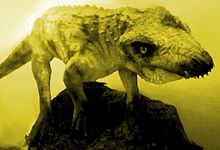Montealtosuchus was an extinct genus of terrestrial crocodyliform.[1] It was discovered in 2004 in the Bauru Basin of Brazil, from Campanian-Maastrichtian deposits of the Adamantina Formation. The species was described in 2007,[2] and assigned to the family Peirosauridae.[1] The type species is M. arrudacamposi. The genus takes its name from the type locality in Monte Alto municipality.
| Montealtosuchus Temporal range: Campanian - Maastrichtian
| |
|---|---|

| |
| Life restoration of M. arrudacamposi | |
| Scientific classification | |
| Domain: | Eukaryota |
| Kingdom: | Animalia |
| Phylum: | Chordata |
| Class: | Reptilia |
| Clade: | Archosauria |
| Clade: | Pseudosuchia |
| Clade: | Crocodylomorpha |
| Clade: | Crocodyliformes |
| Suborder: | †Notosuchia |
| Clade: | †Sebecosuchia |
| Clade: | †Sebecia |
| Family: | †Peirosauridae |
| Genus: | †Montealtosuchus Carvalho et al., 2007 |
| Species | |
| |

This fossil, which was found in 2004, near the town of Monte Alto, in São Paulo state is very well preserved and quite complete. Most importantly, skull material has been found and this can help to link this fossil specimen with today's modern crocodiles. It would have grown to about 2 metres in length and would have been an active predator of smaller animals including dinosaurs. Perhaps it was more terrestrial than its modern relatives, using its semi-upright gait to pursue prey.[3]
External links and references edit
- ^ a b C. F. C. Geroto and R. J. Bertini. (2019). New material of Pepesuchus (Crocodyliformes; Mesoeucrocodylia) from the Bauru Group: implications about its phylogeny and the age of the Adamantina Formation. Zoological Journal of the Linnean Society 185(2):312-334
- ^ I. d. S. Carvalho, F. M. d. Vasconcellos, and S. A. S. Tavares. (2007). Montealtosuchus arrudacamposi, a new peirosaurid crocodile (Mesoeucrocodylia) from the Late Cretaceous Adamantina Formation of Brazil. Zootaxa 1607:35-46
- ^ "Crocodile "Missing Link" Unearthed in Brazil". February 2008.